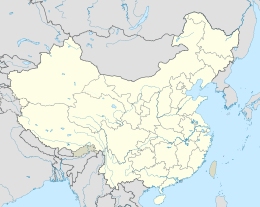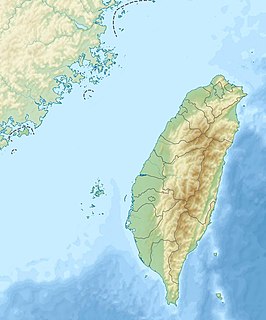
The Taiwan Strait, also known by other names, is a 180-kilometer (110 mi)-wide strait separating the island of Taiwan from mainland China. The strait is currently part of the South China Sea and connects to the East China Sea to the north. The narrowest part is 130 km (81 mi) wide.

USS Seawolf (SS-197), a Sargo-class submarine, was the second submarine of the United States Navy named for the seawolf.

USS Tang (SS-306) was a Balao-class submarine of World War II, the first ship of the United States Navy to bear the name Tang. She was built and launched in 1943.
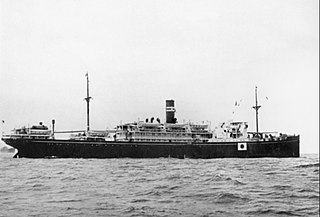
Montevideo Maru was a Japanese auxiliary ship that was sunk in World War II, resulting in the drowning of many Australian prisoners of war and civilians being transported from Rabaul. Prior to the war, it operated as a passenger and cargo vessel, traveling mainly between Asia and South America.

USS Bluefish (SS-222), a Gato-class submarine, was the first ship of the United States Navy to be named for the bluefish. Between 9 September 1943 and 29 July 1945 she completed nine war patrols. Her operating area extended from the Netherlands East Indies to the waters south of Honshū. According to the notoriously unreliable JANAC accounting, Bluefish sank 12 Japanese ships totaling 50,839 tons.

USS Sunfish (SS-281), a Gato-class submarine, was the first ship of the United States Navy to be named for the ocean sunfish, Mola Mola, a plectognath marine fish, having a deep body truncated behind, and high dorsal and anal fins.

USS Spadefish (SS/AGSS-411), a Balao-class submarine, was the first ship of the United States Navy to be named for the spadefish. Although she was commissioned late in the war and spent only one year in the Pacific war zone, she was to run up a record of 88,091 tons in 21 ships and numerous trawlers sunk.

USS Pomfret (SS-391), a Balao-class submarine, was a ship of the United States Navy named for the pomfret, a fish of the seabream family which is a powerful and speedy swimmer, capable of operating at great depths.

USS Queenfish (SS/AGSS-393), a Balao-class submarine, was the first ship of the United States Navy to be named for the queenfish, a small food fish found off the Pacific coast of North America.

Nippon Yusen is Japanese shipping company and is a member of the Mitsubishi keiretsu. The company has its headquarters in Chiyoda, Tokyo, Japan and a fleet of about 800 ships, that includes container ships, tankers, bulk and woodchip carriers, Ro-Ro car carriers, reefer vessels, LNG carrier and cruise ships.
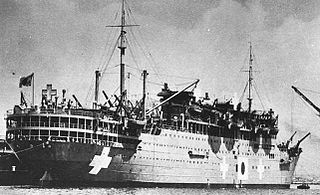
MS Aramis was built for France's Messageries Maritimes for the France-Southeast Asia colonial route. One of her distinguishing features was that her funnels were square-shaped. She was built to carry 1,045 civilian passengers in first, second, third, and steerage class. She was converted to an armed merchant cruiser when France entered World War II, until demilitarized following the Second Armistice at Compiègne on 22 June 1940. Aramis was seized by Japan in 1942, renamed Teia Maru (帝亜丸), and served as a repatriation ship in 1943. She served as a transport between Singapore and Japan in 1944 until sunk in the battle for convoy Hi-71 while assigned to the defense of the Philippines.
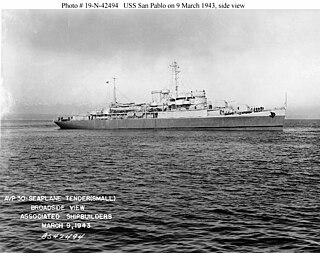
USS San Pablo (AVP-30) was a United States Navy Barnegat-class seaplane tender which was in commission as such from 1943 to 1947 and then served as a commissioned hydrographic survey ship, redesignated AGS-30, from 1948 to 1969. Thus far, she has been the only ship of the United States Navy to be named for San Pablo Bay, a shallow northern extension of San Francisco Bay in California.

Asama Maru was a Japanese ocean liner owned by Nippon Yusen Kaisha (NYK). The ship was built in 1927–1929 by Mitsubishi Shipbuilding & Engineering Co. at Nagasaki, Japan. The vessel was named after an important Shinto shrine.

Pingtan or Haitan Island is an island off the east coast of Fujian Province, China, south of the complex estuary of the Min River. It is the largest island in Fujian and the fifth-largest island in China.

Sōya (宗谷) is a Japanese icebreaker that serves as a museum ship in Tokyo after a long and storied service spanning some of the 20th century's historic events. It is named for Sōya Subprefecture in Hokkaido.
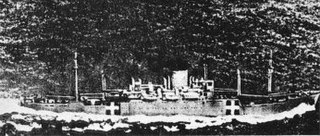
The Awa Maru (阿波丸) was a Japanese ocean liner owned by Nippon Yusen Kaisha. The ship was built in 1941–1943 by Mitsubishi Shipbuilding & Engineering Co. at Nagasaki, Japan. The vessel was designed for passenger service, but the onset of war by the time work was completed changed requirements, and she was requisitioned by the Japanese Navy. While sailing as a hospital ship under the protection of the Red Cross in 1945, she was torpedoed by USS Queenfish (SS-393), killing all but one of 2,004 people aboard.

Pingtan County is a county comprising 126 islands in the Taiwan Strait, it is under the administration of the prefecture-level city of Fuzhou, the capital of Fujian Province, China. Now it is also the subject of newly founded Pingtan Comprehensive Pilot Zone (平潭综合实验区). The main island is Haitan Island.

Convoy Hi-71 (ヒ-71) was one of the World War II Hi convoys of fast tankers and troop transports from Japan to Singapore. The heavily defended convoy was specially loaded with reinforcements for defense of the Philippines, and encountered a wolfpack of United States Navy submarines in the South China Sea after being scattered by an August 1944 typhoon. Personnel losses were high because heavy seas prevented rescue of crewmen from sunken ships.
The Port of Fuzhou is a natural seaport centered on the estuary of the Minjiang River artificial deep-water international seaport on the coast of Fuzhou, Fujian, People's Republic of China. and of the neighboring prefecture of Ningde. The Port is located on the southeastern coast of Fujian, facing the Taiwan Strait. Fuzhou is the Mainland port closest to Taiwan, being just 149 Nautical miles from Keelung.

Musu Point or Musu Dan is a North Korean headland in the middle of the country's eastern coast along the Sea of Japan. It forms the eastern side of North Hamgyong's Hwadae County and the northern point of East Korea Bay.

